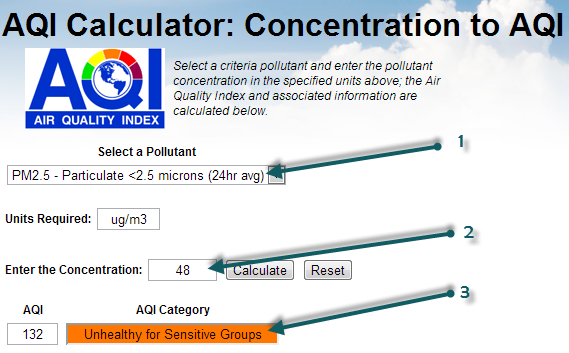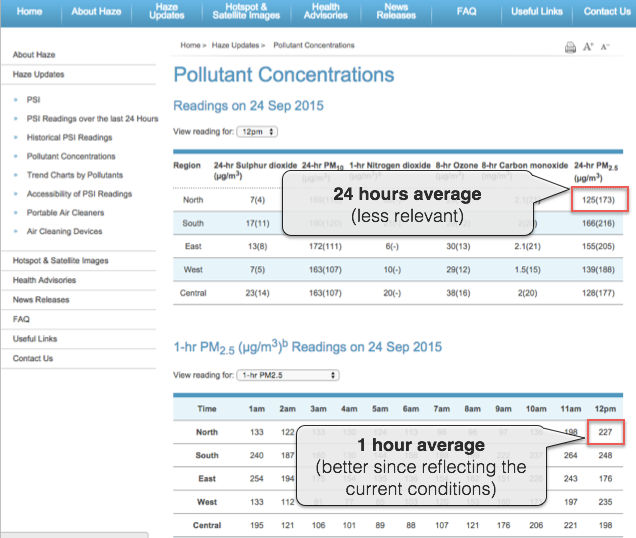In April 2014, the Singapore NEA has updated the PSI calculation to also include PM2.5. http://www.nea.gov.sg/anti-pollution-radiation-protection/air-pollution-control/psi
Com a recente poluição atmosférica do Sudeste Asiático da Indonésia afetando Cingapura e agora a Malásia , recebemos muitas perguntas sobre por que há uma diferença entre os dados que podem ser lidos no site da NEA de Cingapura ( nea.gov.sg ) e no projeto do Índice Mundial de Qualidade do Ar em Cingapura. página da Internet .
Por exemplo, aqui está o que pode ser lido hoje no site da NEA:

Por alguma razão histórica, Singapura está a utilizar o PSI ( Índice Padrão de Poluentes ) para avaliar a Qualidade do Ar. Na imagem acima, o número 1 corresponde ao valor PM10 que é utilizado para a avaliação do PSI. O valor 67(/59) pode ser lido como 67 μg/m3, correspondendo a um PSI de 59. O PSI é avaliado como o máximo do PSI individual para cada um dos poluentes: PM 10 , SO 2 , NO 2 , O 3 (Ozônio) e CO 2 .
PSI(Singapore-North) = max( PSIPM10-based, ... PSIO3-based )= max (59, ..., 77) = 77
Dito isto, o interessante é que, nesta mesma tabela, os dados PM2,5 também são fornecidos na última coluna (ver 3). Estes dados são fornecidos apenas em μg/m3 (ver 2) e não há conversão para algo como o PSI (ou seja, uma conversão da massa de PM2,5 para um Índice de Poluição ou Qualidade). Esta conversão, no entanto, existe e é definida pela Agência de Proteção Ambiental dos EUA . A maneira mais fácil de fazer a conversão é usar a calculadora online, disponível em airnow.gov :

If you select the PM2.5 (1), then enter the mass concentration of 48 (2), can click on Calculate, you will obtain the AQI of 132 (3). So, based on the PM2.5 AQI conversion, the PSI that is used for Singapore could be extended (let's call it PSI++) to also take into account the PM2.5 information. In which case, the PSI++ would be the maximum of the regular PSI (based on PM10 only) and the PM2.5 AQI:
PSI++ = max( PSI, AQIPM.25 ) = max( 77, 132 ) = 132
This PSI++, that is commonly referred as AQI (or Air Quality Index), is what is being used on the the World Air Quality Index project, for all the cities (provided PM2.5 is available for the city). And this explains why the values are different between the NEA website and the World Air Quality Index project.
Moreover, when doing the convertion, make sure you use the 1-hour reading for the PM2.5 concentration rather than the 24-hours averaged value, as shown on the below image:

http://www.haze.gov.sg/haze-updates/pollutant-concentrations/type/PM25-1Hr
If you want to know more about PM10 vs PM2.5, and especially why PM10 is still used, please check the faq entry about why is PM2.5 often higher than PM10? Is PM10 still a relevant measure?
--
For more information about specific countries or continent, please refer to those articles: Thailand and Malysia - India - China - Hong Kong / Canada (Air Quality Health Index) - South America - Australia - Quebec and Montreal - Singapore - Poland - Indonesia .
For information about the 24 hours averaging used or Ozone and Particulate Matter (PM2.5), please refer to those two articles: Ground Ozone Index - PM2.5 Instant Cast
